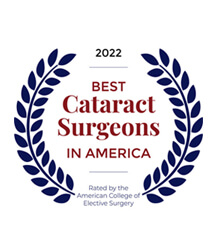January is Glaucoma Awareness Month. But glaucoma is a disease to be aware of every month, especially if you’re at risk of developing it. Each year, we diagnose and treat glaucoma patients from across Dallas/Fort Worth. Determining glaucoma risk is routine for our patients considering surgery.
Glaucoma can severely damage vision. It’s generally caused by increased eye pressure brought on by an imbalance between the amount of fluid your eye produces and must drain away. This helps keep the shape of the eye properly rounded, which affects its ability to see. Just like a ball requires just the right amount of air, your eye needs the right balance of fluid.
There are different types and severities of glaucoma. The two main types are Open-Angle Glaucoma (about 90% of cases), and Angle-Closure Glaucoma (less common, more severe). With Open-Angle Glaucoma drainage canals slowly clog over time with less noticeable symptoms. With Angle-Closure Glaucoma drainage canals more rapidly clog causing blockage and more noticeable symptoms. Another, called Normal-Tension Glaucoma, is different in that the optic nerve is damaged without increased eye pressure.
Naturally, being aware of the risk factors can go a long way towards diagnosing symptoms early to minimize vision loss. So who’s most susceptible? This can depend on your age, ethnicity, health, and genetics.
Age: People over 60 have a higher risk, particularly those of Hispanic heritage. The risk factor skews much younger (40 or older) for African Americans, who are also at a higher risk for blindness from glaucoma.
Eye Health: Elevated eye pressure from injuries, eye tumors, retina detachment, eye inflammation and lens dislocation can increase risk. Being nearsighted or farsighted can also increase risk for certain types.
Overall Health: According to experts, your risk factor goes up if you have diabetes, heart disease, high blood pressure or hypothyroidism. Also, long-term usage of corticosteroids, especially if this involves using eye drops for extended periods.
Genetics: Like any disease, family history determines your risk. This is usually tied to Primary Open-Angle glaucoma, the most common type.
Whether you’re at risk or not, there’s no guarantee you will get glaucoma. The good news is that vision loss can be minimized if glaucoma is treated early. The better news is that an annual eye exam is easy and can reveal early signs. Treatment can range from simple eye drops to surgery.










